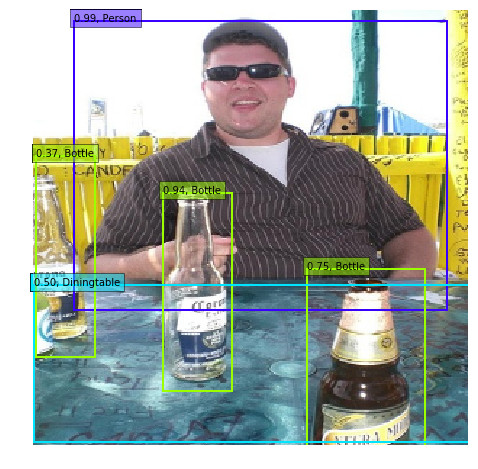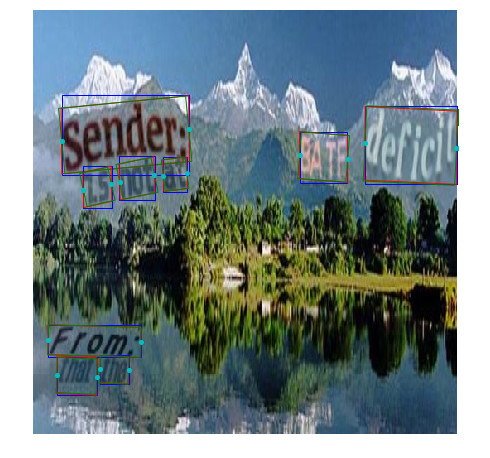This repository contains the implementation of various approaches to object detection in general and text detection/recognition in particular.
Its code was initially used to carry out the experiments for the author's master thesis End-to-End Scene Text Recognition based on Artificial Neural Networks and later extended with the implementation of more recent approaches.
Most of the ideas used for this project go back to the following papers:
SSD: Single Shot MultiBox Detector arXiv:1512.02325
SSD is a generic object detector that does local regression and classification on multiple feature maps of a CNN to predict a dense population of bounding boxes, which are subsequently filtered by a confidence threshold and NMS.
TextBoxes: A Fast Text Detector with a Single Deep Neural Network arXiv:1611.06779
TextBoxes is a modification of SSD that uses non-square convolution kernels and prior boxes with a large aspect ratio to better detect horizontal text.
DSOD: Learning Deeply Supervised Object Detectors from Scratch arXiv:1708.01241
DSOD is a modification of SSD that uses DenseNet as backbone architecture and thus can be trained form scratch instead of depending on a pretrained VGG-16 model.
Detecting Oriented Text in Natural Images by Linking Segments arXiv:1703.06520
SegLink builds on SSD and detects oriented text by locally predicting text segments (objects in SSD) and there linking with each other. The segments (edges) and links (vertices) are considered as a graph and thresholded by confidence. The remaining groups are finally combined to form bounding boxes.
TextBoxes++: A Single-Shot Oriented Scene Text Detector arXiv:1801.02765
TextBoxes++ extends TextBoxes for arbitrary oriented text by predicting horizontal bounding boxes as well as quadrilaterals and oriented bounding boxes. It additionally uses the recognition score to eliminate false positives from the detection stage (currently not implemented).
Focal Loss for Dense Object Detection arXiv:1708.02002
The focal loss is a dynamically weighted version of the cross entropy loss that can better handle a large imbalance between the classes and focus the training process on the difficult samples. It can be applied to the aforementioned detectors, instead of hard negative mining, to overcome the dominance of the background class.
An End-to-End Trainable Neural Network for Image-based Sequence Recognition and Its Application to Scene Text Recognition arXiv:1507.05717
CRNN is a relatively simple architecture with some convolutional-pooling blocks, followed by two bidirectional LSTM (GRU in this implementation) layers, which can be trained with a CTC for efficient text recognition. It can be used to read the text in the cropped bounding boxes generated by the text detectors mentioned above.
Xception: Deep Learning with Depthwise Separable Convolutions arXiv:1610.02357
Separable Convolution splits up the normal convolution operation into a channalwise Depthwise Convolution and a subsequent 1x1 convolution. This trick reduces the number of parameters, especially for large kernel size.
MobileNets: Efficient Convolutional Neural Networks for Mobile VisionApplications arXiv:1704.04861
Separable Convolution got its attention not only through Francois Chollet's Xception architecture and the Keras implementation, but most of all through the MobileNet architecture.
Currently supported datasets for object detection are
- PASCAL VOC
- MS COCO
and supported datasets related to text are
- ICDAR2015 FST
- ICDAR2015 IST
- SynthText
- MSRA TD500
- SVT
- COCO Text
For more information about the datasets, see datasets.ipynb.
For suitable versions of the necessary dependencies, see environment.ipynb.
The usage of the code is quite straightforward.
- use git to clone the repository
pip install -r requirements.txt- run the related Jupyter notebooks. Some of the scripts (e.g. for video and model conversion) can also be executed form the command line.
Pretrained SSD models can be converted from the original Caffe implementation.
PASCAL VOC 07+12+COCO SSD300* from Caffe implementation
PASCAL VOC 07+12+COCO SSD512* from Caffe implementation
COCO trainval35k SSD300* from Caffe implementation
COCO trainval35k SSD512* from Caffe implementation
initialized with converted SSD512 weights
trained and tested on subsets of SynthText
segment_threshold 0.60
link_threshold 0.25
precision 0.884
recall 0.854
f-measure 0.869
parameters 24,358,681
model size 94 MB
trained and tested on subsets of SynthText
segment_threshold 0.60
link_threshold 0.50
precision 0.937
recall 0.926
f-measure 0.932
parameters 12,905,177
model size 50 MB
trained and tested on subsets of SynthText
threshold 0.35
precision 0.984
recall 0.890
f-measure 0.934
parameters 23,477,798
model size 91 MB
the number of parameters has been reduced by ≈ 0.94% compared to the original TextBoxes++ with VGG backbone (35,763,078 parameters)
trained and tested on subsets of SynthText
threshold 0.45
precision 0.973
recall 0.879
f-measure 0.924
parameters 2,226,374
model size 9 MB
trained and tested on cropped word level bounding boxes form SynthText
mean editdistance 0.332
mean normalized editdistance 0.081
character recogniton rate 0.916
word recognition rate 0.861
iterations 400k
parameters 8,747,351
model size 34 MB
runtime (GPU) 114 ms ± 2.75 ms
trained and tested on cropped word level bounding boxes form SynthText
mean editdistance 0.333
mean normalized editdistance 0.081
character recogniton rate 0.916
word recognition rate 0.858
iterations 400k
parameters 7,959,895
model size 31 MB
runtime (GPU) 85.1 ms ± 1.19 ms
fully convolutional architecture for the recognition stage (probably not optimal)
trained and tested on cropped word level bounding boxes form SynthText
mean editdistance 0.355
mean normalized editdistance 0.086
character recogniton rate 0.911
word recognition rate 0.847
iterations 600k
parameters 7,877,719
model size 31 MB
runtime (GPU) 3.68 ms ± 24.5 µs
fine-tuned fully convolutional model on concatenated word images form SynthText
 mean editdistance 1.842
mean editdistance 1.842
mean normalized editdistance 0.064
character recogniton rate 0.939
sample recognition rate 0.517
iterations 600k+100k














